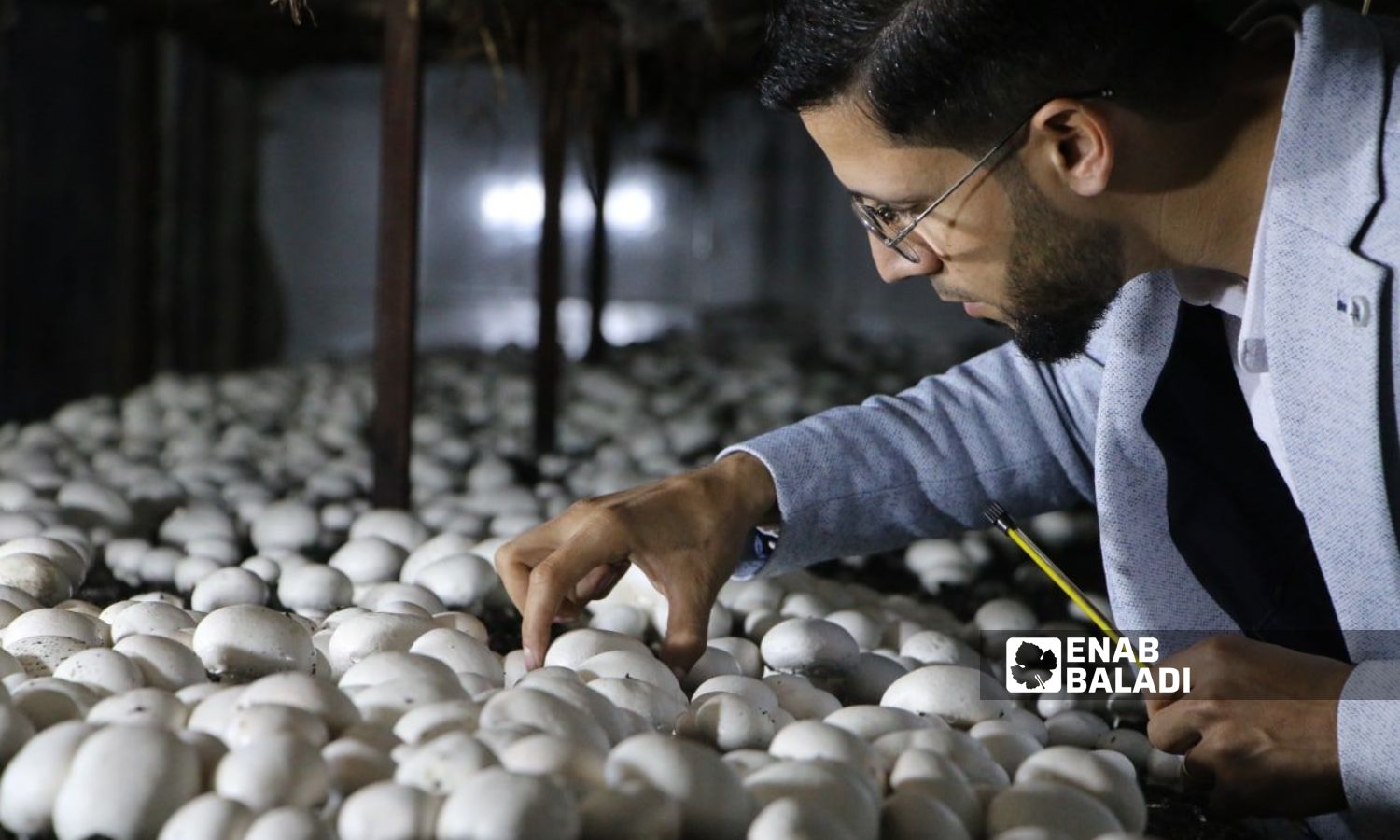



Idlib – Shams al-Din Matoun
The misty weather and high humidity are favorable factors that assist in the growth of wild mushrooms between the bushes, on the mountainous heights, and in the agricultural lands of Idlib province.
The mushroom growth season starts at the end of December every year and continues during the cold days, especially with the presence of fog or light rains, where this stage is characterized by high humidity, low light, and fragile soil. Therefore, mushroom picking becomes an eagerly awaited annual journey and a rich meal for the locals.
Mushrooms are a beloved meal by many for their various health benefits. The increase in their price has transformed mushrooms into an income source for some families, whether through foraging from nature or cultivating them at home. The simple conditions required for their cultivation and their robust growth over a short period have encouraged people to cultivate them.
Hassan al-Issa, a young man from the rural areas of al-Rouj Plain in Idlib, goes out with his friends on a mushroom-foraging journey across the plains and heights.
“Whenever there is fog, there is mushroom,” said al-Issa, explaining to Enab Baladi that he has been accustomed to this journey for years, searching for mushrooms to prepare his favorite foods, such as grilling over a heater or roasting mushrooms with onions and oil.
Al-Issa pointed out that the wild mushrooms have various shapes and types, while the locals focus on collecting only two types, fearing the poisonous mushrooms, which are scarce but have no safe way to distinguish them.
The white mushroom or the cultivated type, according to al-Issa, is distinguished by its white exterior and tends to brown under its cap. The other type, which is more common and known as stubble rosegill, is characterized by its brown exterior and its umbrella-like shape; the inside is grayish with a slimy substance on its surface.
Locals go out to search for wild mushrooms to get a meal for the family, while its trade becomes active during periods of intense fog, where growth increases in the mountainous areas.
The preparation for home mushroom cultivation begins at the end of September in order to plant them with the onset of winter.
Jihad Ziadeh, a displaced person from rural Damascus residing in al-Foua, grows oyster mushrooms in one of the rooms at his residence. He told Enab Baladi that what encouraged him to cultivate mushrooms were the simple factors needed for their growth, in addition to the availability of a good market for selling mushrooms, where the price per kilo ranges between two and three dollars, depending on the quality of the type.
Ziadeh explained that the conditions required for mushroom growth include moderate temperature and high humidity of over 80%, darkness during the incubation period, and light and venting during the fruiting period. This cultivation takes place in closed rooms.
Mushroom cultivation begins by securing seeds available in agricultural pharmacies, and they can also be obtained from wild mushrooms that are collected from nature.
According to Ziadeh, the cultivation is done in plastic bags filled with soil and wheat straw (hay), before sealing the bags tightly and placing them in a dark and warm room for about 20 days. After this period, mushroom growth begins outside the bags, and the process ends with the harvesting of the fruits.
This type of cultivation encourages many to start similar projects, given the low production cost and the few weeks needed to harvest the crop.
Regarding the cultivation process, the agricultural engineer Khadr Hassan al-Khader explained to Enab Baladi that oyster mushrooms are among the most famous varieties being cultivated, and they come in types according to their color.
He said that mushroom cultivation happens in plastic cages or perforated nylon bags, explaining that the cultivation requires special care conditions of moisture, heat, and lighting according to each growth stage, in addition to the preparation of raw materials.
He mentioned that the diseases that mushroom cultivation might suffer from include insect-related ones, called “mushroom flies,” and bacterial ones that can be recognized by spots on the surface of the fruiting body. Both can cause damage to the fruiting body, making it unfit for consumption. Therefore, it is necessary to perform sterilization and pasteurization when cultivating mushrooms on farms to protect the mushroom spores.
The fruits of wild mushrooms (cultivated mushrooms) vary, according to al-Khader, and there are several varieties, including medium-sized white ones, with brown colors underneath their gills, and yellow ones, also medium-sized, with brown colors for the gills as well. There are also large white ones, a white spherical one with thick walls known as “truffles.”
Many types of mushrooms spread in the region, some edible (non-poisonous) and some inedible (poisonous), and distinguishing between them can be difficult. It requires laboratory analysis, but there are some commonly known indicators that may help identify poisonous and non-poisonous mushrooms based on their shape or nature of growth.
Some of these indicators include that the poisonous mushroom grows on tree trunks in an overlapping manner, like mushrooms that grow in large colonies, and mushrooms with unusual colors or mushrooms that appear swollen in the fruiting body. Also, the types that secrete liquids when cut.
The gills found on the undersurface of the fruiting body of the poisonous mushroom are small and numerous, and some poisonous mushrooms can be identified by their long, hollow, thin stems. Meanwhile, some poisonous mushrooms resemble edible varieties, with a white fruiting body and a central brown spot, which is considered an indicator of toxicity.
if you think the article contain wrong information or you have additional details Send Correction